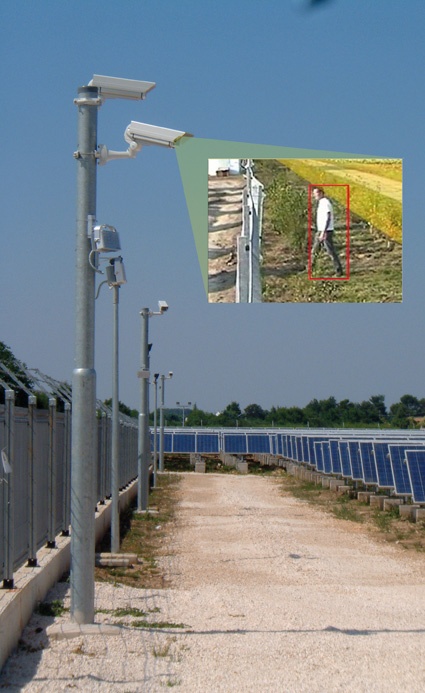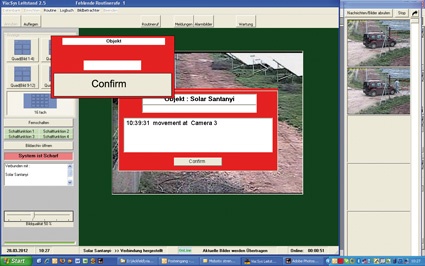High-end Video Alarm Technology plus Professional Emergency Service
Globally, photovoltaic systems connected to the grid rose from 16.6 GigaWatt (GW) in 2010 to 27.7 GW in 2011. The number of markets reaching more than 1 GW of additional capacity d...


Globally, photovoltaic systems connected to the grid rose from 16.6 GigaWatt (GW) in 2010 to 27.7 GW in 2011. The number of markets reaching more than 1 GW of additional capacity during 2011 rose from 3 to 6. In 2010 the top 3 markets were Germany, Italy and the Czech Republic; in 2011 Italy leads the ranks and Germany, China, the USA, France and Japan follow, each with over 1 GW of new capacity.
In an article in the May issue of GIT SECURITY in 2010 we did show how huge solar parks can be effectively protected against vandalism, sabotage and theft by intelligent video alarm systems. Through the implementation of thermal cameras and an enhanced connection to monitoring service providers, solution provider viasys has further improved their solution for an extremely efficient surveillance of solar parks.
Efficient Perimeter Protection
One of the best concepts for the protection of outdoor area photovoltaic power plants is fence protection that combines video surveillance with high-end video analytics. High-end video analytics reliable generates alarm images in case of a perimeter violation. The "classic way" to combine video surveillance with sensors includes the use of mast-fitted high quality day/night cameras in combination with LED infrared illuminators. The data captured by the cameras is transmitted to video analytics system where the data is analysed.
"The video analytics software installed is of vital importance," says Hannes Ackfeld, CEO of viasys. "Simple virtual trip wire and motion detection functionalities that are sometimes included in camera software, are not sufficient."
Motion detection is sometimes referred to as a 2D tool, while state-of-the-art video analytics allows you a view into the third dimension and to differentiate between objects close to the camera and objects far away. The software must exclude false alarms triggered by animals or weather but at the same time detect relevant incidents like intruders or vehicles reliably and then directly transmit the alarm images to the connected monitoring centre in order to start the predefined intervention. The viasys analysis software permanently checks the delivered images for movements and analyzes them using various complex software filters. Different parameters and advanced algorithms are used to customize filters for different situations. An alarm is only triggered in response to a clear motion sequence.
In standard video surveillance situation, an operator has to constantly monitor the screen for incidents. This leads to a heavy workload, decreased concentration and a low reaction speed. A recent study that examined CCTV operators watching a 90-minute video with the task to verbally report the detection of four target behaviours, showed that almost a quarter of the operators lost concentration in the first thirty minutes, almost two thirds in the second thirty minutes. The viasys video alarm system recognises only relevant movements by eliminating most of the inconsequential activities like animals, moving clouds etc. Until an alarm is triggered by persons or vehicles and an alarm image is transmitted to the monitoring centre, the screen remains black. In case of an alarm, the corresponding video picture is displayed immediately with the motion marked by a detection frame like a pop-up on the screen.
Fast Reaction Via a Control Centre
"It is crucial for a 24/7 protection of solar parcs that the sites are directly connected to a competent security control centre," adds Hannes Ackfeld. "We work with leading emergency hotlines and security control centers like ADT, G4S, La Vigilanza, Prosegur, Securitas, Pysec and W.I.S. We have developed specific intervention plans for every possible event that might occur. With the advanced software not only an alarm pops up at the operator's screen, but he also gets displayed all the instructions and options for action to be taken. Every step is documented and the client gets a detailed alarm protocol that makes it easy to check the whole system. This is also important to prove that everything was done the correct way e.g. if there are discussions with insurance companies or the owners of the solar parc. Providing a solution means not only to capture an incident with the camera, to analyze it, to forward the alarm to an operator but also to complete the process chain until the police takes over or patrol arrives at the site. So often we do find that components of a process chain work well but not the whole system. This has lead us to create our own control room software tailor-made for an alarm work-flow."
Video or Thermal Imaging?
Although for a high accuracy of the video alarm system high quality cameras are necessary, only a low bandwidth is required for the connection to the emergency hotline. For remote sites it is possible to send the alarm message and pictures from the site via UMTS mobile phone networks. The quality of the pictures is sufficient to decide what action is to be taken to react on the threat. Especially in the US, more and more installations are built, where independent units of poles equipped with solar panels, cameras and a battery work together via a wireless networks without any cabling.
Since 2007 viasys has already protected over 200 sites in Germany, Spain, Italy, France, Bulgaria, Czech Republic and USA. The large number of installations is a proof of the reliability of the system and is the basis for the experience the company now can rely on. In the first years viasys was installing CCTV cameras combined with their video analytics software.
"The introduction of modern thermal cameras and the price decrease for these cameras make them an interesting alternative. We think that within the next years thermal cameras will dramatically change the situation for video analytics. Video detection with thermal imaging cameras does work excellent in outside conditions. In bad lighting conditions where video footage from CCTV cameras needs additional LED IR illumination, thermal imaging cameras still deliver the high contrast footage that is necessary for video analytics,"adds Hannes Ackfeld.
It takes 8 minutes 19 seconds for light to travel from the sun's surface to earth, some seconds to transfer the energy of the sun into electric power and with an intelligent perimeter protection system it takes only some more seconds before an intruder of a solar parc creates an alarm that will be taken serious.
Business Partner
viasys Intelligent Video GmbHKoselstrasse 20
60318 Frankfurt am Main
Germany
most read

The Benefits of AI-based Video Surveillance Solutions for Sports Venues
Dallmeier Interview: Artificial intelligence Makes Stadiums Smarter

Machine & plant safety: The winners of category A at the GIT SECURITY AWARD 2026
GIT SECURITY AWARD 2026: Machine & plant safety - an overview of the most innovative solutions

Integrated and Futureproof: Traka’s Next Chapter
Interview with Stefni Oliver on Traka’s Vision for the Future

GIT SECURITY AWARD 2026 - The winners have been announced!
GIT SECURITY AWARD 2026: The best safety and security solutions of the year - now an overview of all winners

Is Your Venue Ready for Martyn’s Law?
Martyn’s Law demands stronger security by 2027. Is your venue prepared to protect and respond?








